
The province of L'Aquila is the largest, most mountainous and least densely populated province of the Abruzzo region of Italy. It comprises about half the landmass of Abruzzo and occupies the western part of the region. It has borders with the provinces of Teramo to the north, Pescara and Chieti to the east, Isernia to the south and Frosinone, Rome and Rieti to the west. Its capital is the city of L'Aquila.
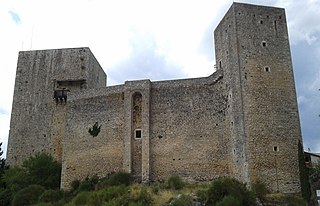
Pereto is a comune and town in the province of L'Aquila in the Abruzzo region of Italy.
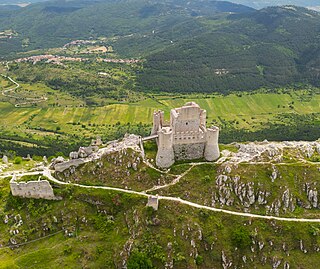
The Castle of Rocca Calascio is a mountaintop fortress or rocca in the municipality of Calascio, in the Province of L'Aquila, Abruzzo, Italy.
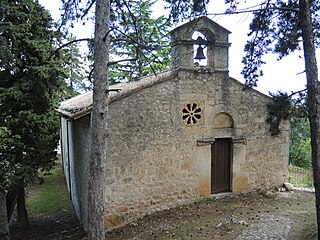
Bominaco is the sole frazione of Caporciano in the province of L'Aquila in the Abruzzo region of southern Italy.

Tourism in Abruzzo has become one of the most prosperous sectors in the economy of Abruzzo, and in recent years has seen a remarkable growth attracting numerous tourists from Italy and Europe. According to statistics, in 2021 arrivals totaled 1,330,887. A total of 5,197,765 arrivals were tourists, a figure that puts the region seventeenth among the Italian regions for numbers of tourists per year. A moderate support to tourism is also given to the Abruzzo Airport with many low cost and charter flights connecting the entire region with the rest of Europe.

The Castle of Barisciano is a medieval castle in Barisciano, province of L'Aquila, Abruzzo, southern Italy.

The Castle of Bominaco is a medieval castle in Bominaco, Province of L'Aquila, Abruzzo, southern Italy.

The Castle of Fossa is a Middle Ages castle in Fossa, province of L'Aquila, Abruzzo, southern Italy.

The Castle of San Pio delle Camere is a medieval castle in San Pio delle Camere, province of L'Aquila, Abruzzo, southern Italy.

Castello di Ocre is a medieval castle in Ocre, Province of L'Aquila, Abruzzo, southern Italy.

Rocca Orsini is a Middle Ages castle in Scurcola Marsicana, Province of L'Aquila (Abruzzo).

The Castle of Sant'Eusanio Forconese is a medieval castle in Sant'Eusanio Forconese, Province of L'Aquila, Abruzzo, southern Italy.
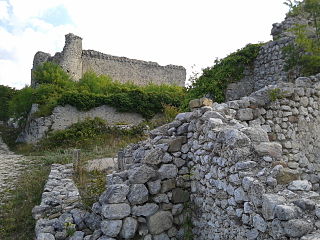
Castello Orsini is a Middle Ages castle in Massa d'Albe, Province of L'Aquila (Abruzzo).

Castello di Oricola is a medieval castle in Oricola, Province of L'Aquila (Abruzzo).
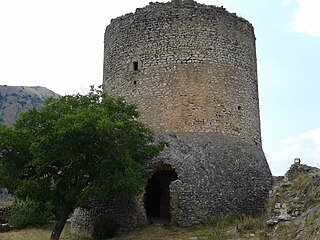
Castello di Ortona dei Marsi is a Middle Ages castle in Ortona dei Marsi, Province of L'Aquila (Abruzzo).
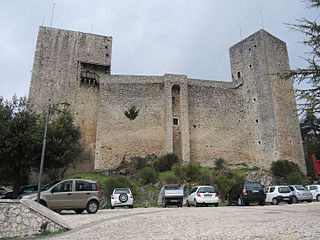
Castello di Pereto is a Middle Ages castle in Pereto, Province of L'Aquila (Abruzzo), Italy.
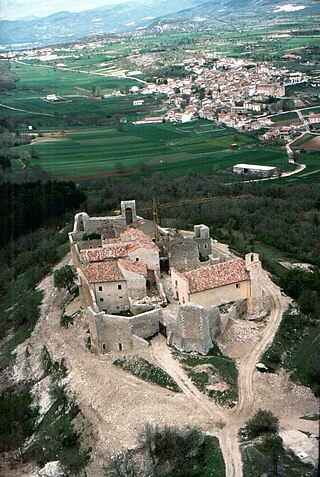
Castel Camponeschi is a Middle Ages castle in Prata d'Ansidonia, Province of L'Aquila (Abruzzo).

Castello De Sanctis is a Middle Ages castle in Roccacasale, Province of L'Aquila (Abruzzo).

Castello ducale Cantelmo is a Middle Ages castle in Popoli Terme, Province of Pescara (Abruzzo).

Museo d'Arte Sacra della Marsica is a museum of religious art in Celano, Province of L'Aquila (Abruzzo).





















